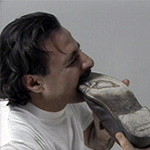When I was young, I was terrible at math. My mom would get upset with me because my grades were so bad. So, for the next exam, she worked a lot with me to prepare and when the grades came out, I had gotten an A+. I remember being so happy. I rushed back home that afternoon to tell my mom the good news. When I got home, I opened the front door, and I remember hearing a loud pounding sound. I felt scared at first, I didnʼt know what the sound was, and slowly walked into the house and through to the kitchen where the sound was coming from. There, I found my mom, sitting at the kitchen table. She was holding a stone in her hand, smashing a heap of olives. One by one, she cracked the olives with her stone, preparing them for pickling.
I remember interrupting her rhythm with the good news. She stopped everything she was doing and jumped from her seat to give me a hug, she even gave me a dollar or two, I canʼt remember the currency. I donʼt know why, but I never forgot about that moment or the feeling of returning home that afternoon. I still have the same stone she used that day, more than fifty years ago. Thatʼs why I titled the video, I want to be with you. I want to be with my mom, I want to be at home.
Brief Histories is proud to present I Want to Be With You by Khalil Rabah, opening Saturday, October 5, and on view until November 16, 2024. The exhibition brings together early works and considers a pivotal period in Rabahʼs conceptual artistic practice where themes of performance, action, and duration take shape in his experimental and interdisciplinary approach.
Tracing an artistic investigation into the lasting impacts of power and control, both personal and collective, as they manifest in the physical and conceptual boundaries of the institution, the landscape and body politics, Rabahʼs work is constantly inverting questions: to ask about what it is not, and in this way, it invents its own identity. Performance is a critical component of Rabahʼs practice and it unfolds throughout the artworks, structures, and institutions the artist produces, such as The Palestinian Museum of Natural History and Humankind, replete with facts entwined with cultural genealogies and branches of departments that protect vulnerable histories while preserving their imagination.
The artworks in I Want to Be With You are a precursor to the Museumʼs Future of Ethnographic Collections, which is made up of a constellation of actions, images, and videos recorded in Palestine in the 1990ʼs. In these works, Rabah references embodied experiences with an incisive examination on the intersections of performance, existence, bearing witness, disappearance, record, and memory. In the video installation Body and Sole (1995), the artist performs a struggle with a shoe, and in the video work Critical Interrogations, Renewed Belief (1999), we see two figures performing a shoulder leap in front of an olive tree in a field in Ramallah. In I Want To Be With You (1998), which was recorded in the artistʼs backyard, the camera is tightly zoomed in on olives as they are being cracked one by one with astone. These video works also travel back to a period when the artist recorded and questioned the self, the signification of the performing body, and oneʼs personal and collective conditions. Photographs and sculptural installations ground the exhibition; Incubation (1995-2017), made up of coils of embroidery threads submerged in olive oil in a steel tray, and Inside Out (2002), composed of an old wardrobe and a hanging suit, transform the gallery into a site of both uncertain absence and anticipation of arrival.
Press release from Brief Histories
Image: Khalil Rabah. Body and Sole at I Want to Be With You at Brief Histories, New York, 2024. Image courtesy of the artist and Brief Histories



